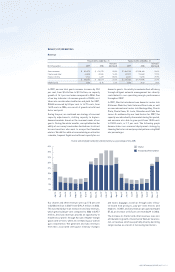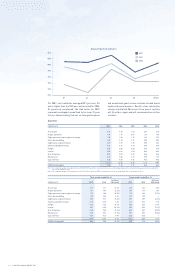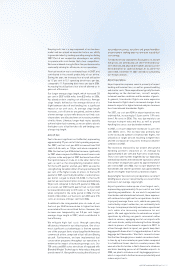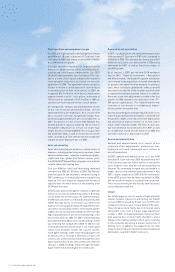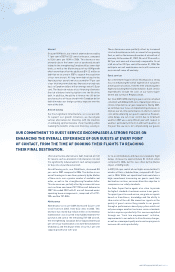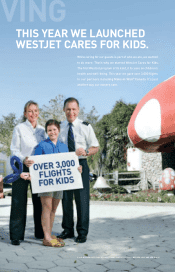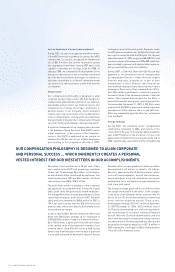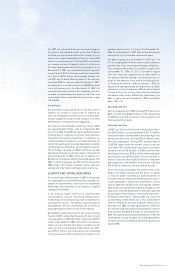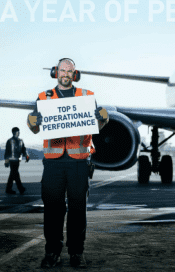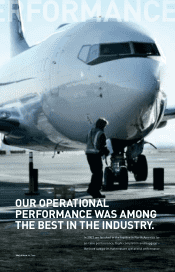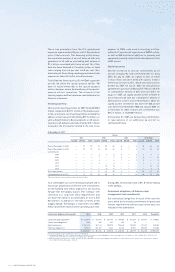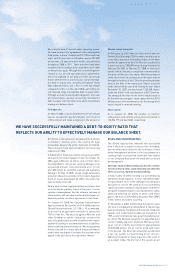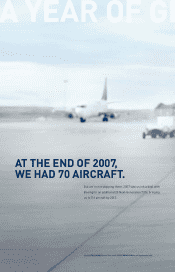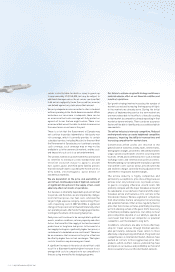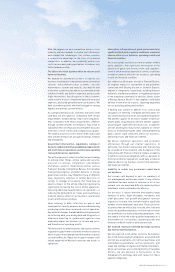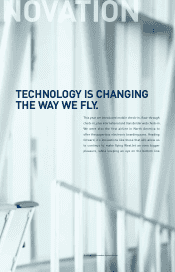Westjet 2007 Annual Report Download - page 25
Download and view the complete annual report
Please find page 25 of the 2007 Westjet annual report below. You can navigate through the pages in the report by either clicking on the pages listed below, or by using the keyword search tool below to find specific information within the annual report.
WESTJET ANNUAL REPORT 2007 PAGE 23
For 2007, we estimated that every one-cent change in
the value of the Canadian dollar versus the US dollar
will have an approximate $6 million impact on our
annual costs (approximately $4 million for fuel and $2
million for remaining costs). During 2007, we entered
into foreign currency forward contracts to offset our
US-dollar denominated aircraft lease payments. As at
December 31, 2007, we entered into forward contracts
to purchase US $5.9 million per month for fi ve months
for a total US $29.5 million at an average forward rate
of 0.9871 per US dollar. Maturity dates for all contracts
are within 2008. For the year ended December 31, 2007,
we realized a loss on the contracts of $18,000 included
in aircraft leasing costs. As at December 31, 2007, the
estimated fair market value of the remaining contracts
recorded in prepaid expenses, deposits and other, and
accumulated other comprehensive income was a gain
of $106,000.
Income taxes
Our operations span several tax jurisdictions, which
subjects our income to various rates of taxation. As
such, the computation of the provision for income taxes
involves judgments based on the analysis of several
different pieces of legislation and regulation.
Our effective consolidated income tax rate for 2007
was approximately 19.3 per cent, as compared to 30.2
per cent in 2006. The 2007 rate was signifi cantly lower
primarily due to corporate income tax rate reductions
enacted by the federal government. In addition, we
realized a benefi cial impact to our future effective tax
rate for the year based on revised expectations of when
certain temporary differences are anticipated to reverse.
These changes resulted in a $33.7 million favourable
adjustment of future income tax expense recognized in
the fourth quarter of 2007, which was in addition to a
$2.3 million recovery recorded in the second quarter. The
2007 income tax expense was $3.7 million lower than
2006’s due to the changes in future income tax rates
partially offset by higher earnings before income tax.
LIQUIDITY AND CAPITAL RESOURCES
Our record fi nancial performance in 2007 resulted from
our ongoing efforts to build infrastructure, manage risk,
prepare for opportunities, and secure our competitive
advantage and reputation in our industry’s rapidly
changing environment.
In an industry highly sensitive to unpredictable
circumstances, such as increasing energy prices,
maintaining a strong fi nancial position is imperative to
our long-term success. Through our cautious fi nancial
management, we have maintained one of the most
favourable balance sheets in the airline industry.
We realized a signifi cant growth in our cash position by
the end of 2007, completing the year with total cash and
cash equivalents of $653.6 million compared to $377.5
million at December 31, 2006. Part of this cash balance
relates to cash collected with respect to advance ticket
sales, for which the balance at December 31, 2007,
was $194.9 million. Our fi nancial position remained
strong as we were able to achieve an increase in our
working capital ratio to 1.2, from 1.0 at December 31,
2006. As at December 31, 2007, WestJet did not have any
investments in asset-backed commercial paper.
Our debt-to-equity ratio at December 31, 2007, was 1.94
to 1.0, including $410.8 million which represented the
present value of our aircraft operating lease obligations.
This compared favourably to our debt-to-equity ratio
at December 31, 2006, of 2.3 to 1. Our debt-to-equity
ratio was impacted negatively by an adjustment to
our opening retained earnings during the period as a
result of the adoption of the new accounting policies
for Financial Instruments. Effective January 1, 2007, we
adjusted our opening retained earnings balance by $36.6
million (net of future income tax of $16.3 million) related
to transaction costs on long-term debt we previously
included in other assets. Without this adjustment, our
debt-to-equity ratio at December 31, 2007, would have
been 1.87 to 1.0.
Operating cash fl ow
Cash from operations in 2007 increased 59.9 per cent to
$541.1 million from $338.3 million for the same period
in 2006 due to growth in earnings from operations and
improved working capital.
Financing cash fl ow
In 2007, our total cash fl ow used in fi nancing activities
was $59.3 million, consisting mainly of $141.2 million
in long-term debt issued related to the fi nancing of four
new purchased aircraft, offset by $156.5 million in long-
term debt repayments. During 2007, we repurchased
1,263,500 shares under the normal course issuer bid
for a total of $21.3 million and made deposits on future
leased aircraft of $18.3 million. In 2006, cash fl ow from
fi nancing activities was $256.6 million, which was made
up of an increase of $418.6 million in long-term debt to
fi nance 12 aircraft, offset by $132.6 million in long-term
debt repayments, $16.0 million in transaction costs and
$10.9 million in deposits on future leased aircraft.
One of the major challenges that airlines face is the
high cost of capital. Having suffi cient access to capital
is critical in order to facilitate our planned growth. At
the same time, we require the fl exibility and resources
to take advantage of unforeseen opportunities as they
arise. In addition to having strong cash liquidity, we have
been successful in fi nancing our growth through aircraft
acquisitions fi nanced by low interest rate debt supported
by the Export-Import Bank of the United States (Ex-
Im Bank) commitments. During 2007, we converted
a preliminary commitment into a fi nal commitment
from Ex-Im Bank for a total of US $249.1 million. As at
December 31, 2007, we have taken delivery of the fi rst
four aircraft under this facility and have drawn a total of
$141.2 million (US $136.9 million). As at December 31,
2007, the unutilized and uncancelled balance of the fi nal
commitment from Ex-Im Bank was US $108.0 million
for three aircraft to be delivered between January and
July of 2008.


